 Technovit 9100 NEW
from Heraeus KULZER
Technovit 9100 NEW
from Heraeus KULZER Technovit 9100 NEW
from Heraeus KULZER
Technovit 9100 NEW
from Heraeus KULZERPolymerisation system for embedding mineralised and soft tissues for use in classical histology as well as immuno- and enzyme-labelled histochemical techniques, including in-situ hybridisation.
この埋め込み用樹脂は、無機組織や軟組織標本作成を、一般的な組織学だけでなく、免疫組織学や酵素組織学のために使用できます。 またIn-Situ Hybridizationにも使用できます。
Areas of Application
Technovit 9100 NEW is a polymerisation system based on methyl methacrylate (MMA) which hardens at low temperature. It has been specially developed for embedding mineralised tissues with extensive possibilities of staining for light microscopy.
Heavy duty microtome technique for preparing thin sections - for example pelvic biopsies, small low- and high-density bone samples.
Cutting-frinding and micro-grinding and micro-grinding system(contact point technique) - for example jaw and teeth segments with and without implant.
Combined contact point and heavy duty microtome techniques(Target Preparation) - for example interface regions and examination of tissues surrounding metal implants and cement-free endoprostheses(target tissue preparation)
Properties
The chemical polymerisation of Technovit 9100 NEW takes place under the eclusion of oxygen with the aid of a catalyst composed of a peroxide and an amine component. Additional components such as PMMA-powder and a regulator allow for a controlled polymerisation by tgemperatures between -8 and -20℃, which gurantee a dispersion of the heat generated during polymerisation. The polymerisation time is betgween 18 and 24 hours ysubg a vikyne between 3 and 15 ml for the above tempemperature range. After necessary pretreatment of the tissue - all current staining methods can be applied to the MMA-sections after removal of the polymer. These include classical staining as well as immuno- and ezyme-histochemistry. In-situ hybridisation (ISH) techniques can also be performed.
The polymerisation system Technovit 7200VLC - developed for classical cutting-grinding and micro-grinding systems (contact-line technique) - retains its proven range of applications and is especcially recommended for use with cemented endoprostheses and implants.
Technovit 7100 and Technovitg 8100 which are based on glycol-methacrylate are especially suitable for small organ biopsies with thin- and semi-thin section techniques and have a well-known wide spectrum of applications.
The embedding systems complement eadh other with respect to the diagnostic and scientific to be answered.
System Components of Technovit 9100 NEW
Basic solution (stabilised) 1000 ml
PMMA-Powder 120 g
Hardener 1 8 Sachets a 1 g
Hardener 2 10 ml
Polymerisation regulator 5 ml
PMMA-Granulate, EXAKT 500 g
1. Basic Solution
The basic solution Technovit 9100 NEW is composed of monomers-organic molecules with at least one carbon-carbon double bond. The stabiliser contained in the kit is responsible for the storage-stability. Hydrophilic properties are improved by addition of a special hydrophilic-generating agent. Technovit 9100 NEW can be used either in the stabilised or destabilised form.
2. PMMA-Powder
The powder is an internal filler and is made up of PMMA-micropellets. It is used
-to reduce the polymerisation-shrinking effect markedly
-to reduce the heat generated during the polymerisation process as well as
-to improve the quality of the polymerised product.
3. Hardener 1
Hardener powder is the one of the components of polymerisation initiation system. It is a derivative of dibenzoyl peroxide which - in combination with Hardener 2 - starts the polymerisation reaction.
4. Hardener 2
This liquid hardener is the second component of the initiation system. It works catalytically upon hardner 1 to allow a controlled polymerisation even at temperatures below 0℃。
5. Regulator
The regulator is composed of a reactive organic compound which allows a controlled polymerisation - even with large volumes of polymer - without large increases in the temperature during the polymerisation reaction.
6. PMMA-Granulate, EXAKT
This granulate acts as an additional internal filler when larger amounts(500-1000ml) of polymer are to be used - as for example in the case of a femur shaft with non-cemented endoprostheses. The amount of monomer (basic solution) is thereby reduced, at the same time making the polymerisation easier to control.
※ 以上の英文を和文に変換致しますので、交互に照らし合わせて参照して頂ければ幸いに存じます。
応用範囲
テクノビット9100NEWは、低温で硬化するメチルメタアクリレート(MMA)を主成分とする硬化システムを採用しております。 さらに、この樹脂は光学顕微鏡のための無機組織の染色に幅広く対応する様に開発されたものです。
薄片作成のための耐久性のあるミクロトーム技術 例)骨盤の生体検査における、小さくて密度の低い骨や高い骨の組織標本
切断、研磨および精密研磨システム(Contact Point Techniques) 例:インプラントを含む顎骨と歯のおよびインプラントを含まない顎骨と歯の組織標本
研磨システムとミクロトーム技術を併用(Target Preparation) 例)部位の境界、金属インプラントの周辺組織およ膠着剤なしの人工官
特長
脱酸素下で硬化触媒に含有される過酸化化合物ならびにアミン化合物により硬化します。 またPMMA粉や調整剤などの添加物は、-8℃〜-20℃までの低温での硬化反応をコントロールします。 さらにこれらの添加物は硬化時の発熱の分散に寄与します。 硬化時間は 3〜15ml の体積で上記の温度の場合、18〜24 時間かかります。 必要な前処理が終了後、MMA 用の全ての染色方法が可能です。 これらの染色方法には、一般染色のほか酵素組織化学および免疫組織化学染色も使用できます。
テクノビット7200VLCの硬化システムは、従来型の切断・研磨・精密研磨(Contact Line Techniques)用に開発されました。 実証されている用途範囲、特に推奨するのは膠着されている人工インプラントです。
テクノビット7100 および 8100は、グリコールメタクリレートを主成分とし、特に小さい器官の薄片の生体検査に適しています。 さらに広い範囲の用途に使用することが出来ます。
これらのシステムは、診断や化学的疑問を解明するにあたって相互に補完し合います。
硬化システムの構成内容
構成 量 構成番号 安定化基材溶液 1000ml 1 PMMA粉 120g 2 硬化剤ー1 1g x 8袋 3 硬化剤ー2 10ml 4 重合調節剤 5ml 5 PMMA粒 500g 6
基材溶液: 基材溶液は、炭素の二重結合を一つ以上持ったモノマーで構成されています。 基材溶液に含有されている安定剤は、保存時の安定性を確保します。 また親水性は、特別な親水性剤の添加により改善されています。 基材溶液は、本来安定化基材溶液ですが、3頁の処理により非安定化基材溶液となります。 目的に応じて、どちらかを選ぶ事が出来ます。
PMMA粉: この粉末は、フィラーとして使用され、PMMAの微粉末で作られています。 また以下のように作用します。 −重合反応による収縮を著しく減少させます −重合反応中の発熱を減少させます −硬化した製品の品質を改善します。
硬化剤ー1: 硬化剤ー1の粉末は、重合を開始させる為の成分の一つです。 ジベンゾイル・パーオキサイドの誘導体で、硬化剤ー2との組み合わせで重合反応が開始します。
硬化剤−2: 硬化剤ー2の液は、重合を開始させる為のもう一つの成分です。 硬化剤ー1の働きを促進する触媒として働き、0℃以下の低温でも重合が進むようになります。
重合調節剤: 重合調節剤は反応性有機成分からなり、重合反応を抑制します。 また大量の樹脂の重合に際しても、発熱を抑える働きをします。
PMMA粒: PMMA粒は、大量の樹脂(500−1000ml)を硬化させる場合に、追加するフィラーとして使用します。 例)膠着されていない人工器官のついた大腿骨の場合、PMMA粒を追加する事で、基材溶液の量を減らすことが出来ると共に、重合反応を抑制することが簡単になります。
以上の説明は技術資料からの抜粋ですので、詳しい資料をご希望の場合はご請求下さる様お願い致します。
※ 上記組み合わせ価格: #04-1001 テクノビット9100 1セット 50,000.-円
Photomicrographs
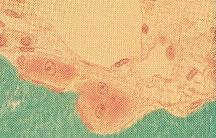 |
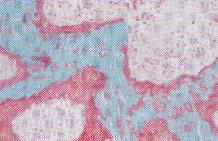 |
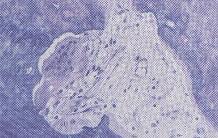 |
| Pelvic biopsy: Renal osteopathy Masson-Goldner Deep Howship's Lacunae with osteoclasten 400x |
Pelvic biospsy: Osteonalacia instestinal form Masson-Goldner osteoid tissue red; meneralised bone green 400x |
Pelvic biopsy: Toluidine Blue Paget's Disease with giant osteoclasts 200x |
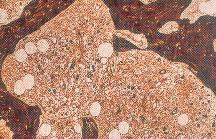 |
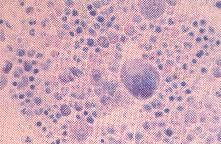 |
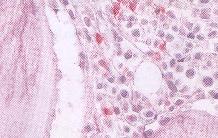 |
| Pelvic biopsy: Myeloproliferative syndrome presenting as osteomyelofibrosis Gomori 200x |
Pelvic biopsy: Reactive hyperplastic bone mattow Giemsa 400x |
Pelvic biop;sy: Reactive hyperplastic bone marrow immunohistochemistry CD45RB (DAKO; APAAP) 400x |
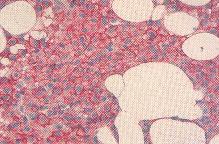 |
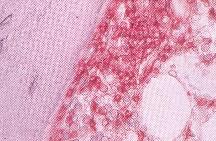 |
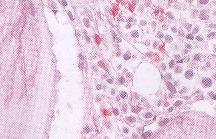 |
| Pelvic biopsy: Hair-cell leukaemia immunohistocheemistry CD20 (DAKO; APAAP) 400x |
Pelvic biopsy: Mantle-cell lymphoma or centrocytoma para-trabecular infiltration immunohistochemistry CD5 (DAKO EnVision) 400x |
Pelvic biopsy: Situation after chemotherapy mamma carcinoma- activated reticulum cells KiM 1P histochemistry CD68 (DAKO EnVision) 400x |
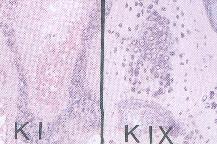 |
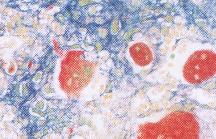 |
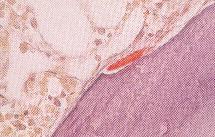 |
| Bone gtumour: Central chondrosarcoma staining of type (K-1) abd type (K-1X) collagens Thin section after EDTA-decal- cification. APAAP; Fast Blue salt; Counterstain Nuclear Fast Red x200 |
Giant Cell Tumour: Enzyme histo chemistry: Combined demon- stration of alkaline(blue)and acid (red)phosphatases. Nuclear coun- terstain methyl green 400x |
Pelvic biopsy: Enzymehistochemi stry: Physiological resorption with shallow Howsip's Lacunae. Demon- stration of acid phosphatase(red) in singly nucleated osteochasts 400x |
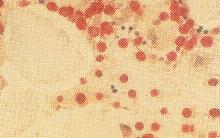 |
 |
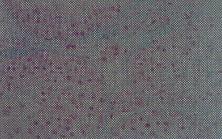 |
| Pelvic biopsy: Enzyme histo chemistry; combined demonstra- tion of specific esterase(naphthyl- AS-D-chloroacetate) in granulo- poetic cells 400x |
Pelvic biopsy: Demonstration of non-specific esterase(neutral_-na phthyl acetate esterase). Reaction product red-brown precipitate in megakaryocytes and monocytes |
Testiclar biopsy: semi-thin-section normal spermatogenesis fixation according to Masson-Goldner 400x |
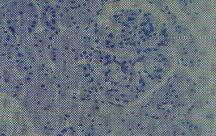 |
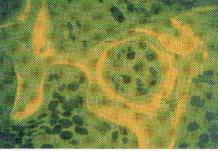 |
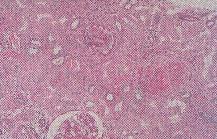 |
| Renal biopsy: Thin section Toluidine blue idiopathic nephrtic syndrome with slight glomerular abnormalities(minimal glomerular cellularity) 400x |
Pelvic biopsy: Osteomalacia with tetracycline Labelling non-stained thin section under ultra-violet light 200x |
Renal biopsy: Thin section diffuse mesangioproliferative and sclerotic glomerulonephritis periodic acid-Schiffe(PAS) 200x |
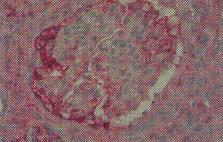 |
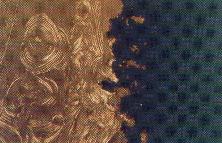 |
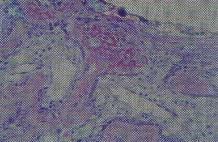 |
| Renal biopsy: Thin section immunohistology lgG DAKO segmented sub-endothelial mesan gial deposits of immune complexes APAAP 600x |
Micro-ground section: Bone implant contact zone, bone-metal contact zone in polarised light 400x |
Hard section: after removal of implant Border area with fibrous bone and activated ostoblasts Giemsa 400x |
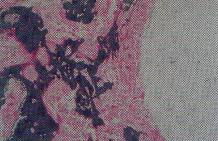 |
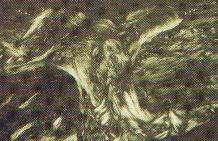 |
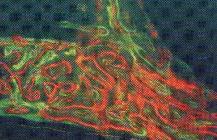 |
| Hard section: After removal of implant Border area with fibrous bone and acrivated osteoblasts Kossa. Mineralisation of fibrous bone 400x |
Thin section: Femur after osteotomy (rat). Osteotomy area in polarised light, fibrous and lamerllar bone inosteotomy cleft unstained 200x |
Thin section in UV-light: Polychromatic sequential labelling for the monitoring of dynamic bone lealing in cleft and at the level of the periostial fracture callous 400x |
| 〒101-0021東京都千代田区外神田5-3-11 |
| 応研商事株式会社 |
| TEL:03(5826)8642 FAX:03(5826)8643 |
| URL: http://www.okenshoji.co.jp |